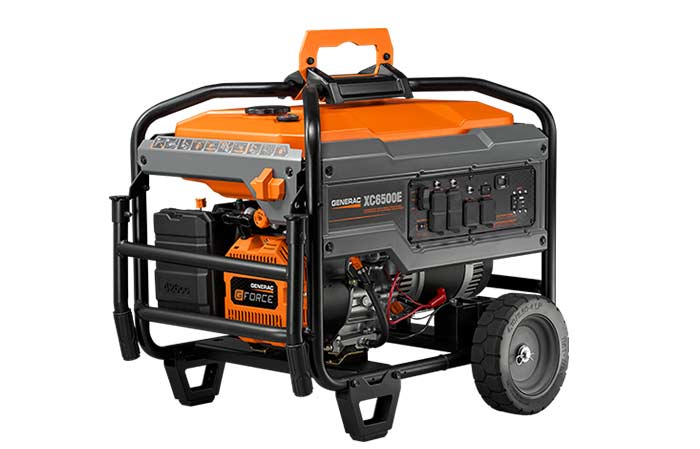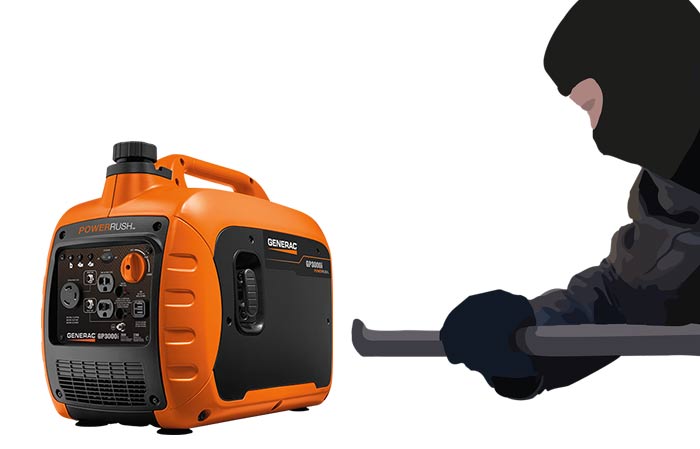Generators, while very handy and almost essential in some circumstances, aren’t cheap to own. The buying price of some of the very best portable generators goes into several tens of thousands and even hundreds of thousands.
Losing a generator is thus a major inconvenience not just in the money value of it, but also the fact that you’ll be losing the supply of power. If you run critical equipment, it’ll be a major loss to your business and can even lead to the loss of life for those generators running important hospital equipment.
You therefore need to secure the generator from theft and damage to enjoy its features the most important of which is power production. Following are 18 ways and tips on how you can keep your portable generator safe, away from burglars, functional breakdowns and wear and tear.
1. Protect it from the first day
One of the most common mistakes people make with generators is buying one, leaving it in an unsecured location with the hope of setting up security measures the next day only to see it stolen that very night.

To save yourself the pain of losing the generator without ever having used it, either build security measures before getting the generator to secure it immediately it arrives, or secure it the moment it arrives.
2. Fence the area around it
Fencing around the generator is one of the most basic and essential safety measures. There’s the basic type of fencing which doesn’t require anything more than a solid fence around it.
However, for the best security from your fence, you can advance the fence such as using more secure types of fencing wire. You can also add a motion-sensor to alert you whenever there’s movement around the generator.
3. Add an alarm system
You can also add a CCTV camera system which alerts you with an alarm whenever someone nears the generator. This also scares off the thief in the case that you’re not around to attend to the alarm.
4. Remove the wheels
The wheels to your generator, while very handy in moving it around, are also handy to the thief who intends to steal the generator especially when your are not using it or it is in a stationary place.
One way to secure the generator is to remove them and instead place it on wooden blocks or another secure surface. This way, a thief wouldn’t find it easy stealing your generator.
5. Light up the area
Adding lights around the generator is one of the most basic routines to keep it safe. Thieves hate well-lit areas and will thus avoid it at all costs.
You can use a combination of solid and motion-sensing lights make it harder to access it. The lights should draw power from both the grid and the generator to ensure an always-on experience.
6. Use storage boxes
Storage boxes are designed to fit specific generators and protect them from both vandalism and theft since they restrict access to the generator. You can also get one made for your generator and an after-market option.
7. Block access to the generator
While fences and other obstacles are great at keeping the generator safe, you should make it hard to access it by using other bigger obstacles in its way.
This way, a thief or vandal won’t find it easy carrying it away once they steal it. You can use other pieces of machinery to block the path leading to and from the generator. Just make sure the generator still gets sufficient ventilation.
8. Protect the fuel
Unchecked access to fuel can lead to both theft and vandalism and should thus be restricted. Fuel can be stolen or used to destroy the generator by simply lighting it up. You should thus store fuel in a secure location that’s safe and well-ventilated.
9. Hang it
You might have seen portable generators at construction sites being suspended by cranes when not in use. It’s not a fancy construction trick but a way to prevent thieves and vandals from accessing the generators. If you can do that with a crane or other viable method, hang it up.
10. Drain its fuel
If you’ll be storing your generator for a long time, consider draining the fuel from its system before storing it. This will prevent the fuel from going stale while in the generator.
If this occurs, it’ll not only be tough to start and run the generator, it’ll also lead to clogs as fuel forms gummy deposits when left sedentary for long.
11. Keep the generator’s details
The details of your generator such as the model number, serial number and others are important as you can hand them over to the police when the generator has been stolen. This way, they can easily track it down far much faster.
12. Use carriage bolts and steel plate
For campers, you can use carriage bolts which are driven into a steel plate and fastened to the generator. The steel plate should be about 2 feet from the point of contact with the generator.
The extra space is then used to pack the car on with the wheels resting on the plate. A thief won’t have it easy stealing it.
Also, a vandal won’t come within 2 feet of a parked car with the aim of destroying the generator. Just make sure the exhaust pipe faces away from the car to prevent carbon monoxide poisoning.
13. Use a lock and key combination
With a fence around the generator, you’ll have a good chance of deterring thieves and vandals. However, without locking it up, you’ll not have done much to keep it safe.
Going for a typical lock with a chain won’t either help much as thieves have tools to cut those in a minute.
Rather, go for hardened locks and chains which require at least a grinder to cut up. It’s highly unlikely that a thief will carry a grinder or flame torch to a generator to steal it.
14. Check the coolant and lubricant levels before starting the generator
The coolant prevents your generator from burning up or generally getting too hot. The lubricant, on the other hand, plays the roles of keeping the moving parts lubricated by reducing friction between them, and also acts as a coolant for the generator.
Both need to be at the right levels and should be checked before the generator is started. If you fail to do this, your generator will likely break down or won’t simply run.
Luckily, modern generators come with gauges that won’t allow the generator to run or even start if it has low levels of lubricant, coolant or fuel as needed.
15. Hire security
One way to keep the generator safe is simply look after it physically. If you’re out camping, you can take turns watching over it to deter thieves and vandals from carrying out their heinous acts. At home, you can hire a guard or guard dog to do the job.
16. Use a power outlet alarm
A power outlet alarm, also known as a power outage alarm or power socket alarm, is a device plugged into a socket.
It can also be used as an extension cord. It’s triggered whenever the power supply is cut, unplugged or the fuel had just run out from your generator. It can thus work whether the generator is running or not.
17. Add a GPS tracker
Adding a GPS tracker on your generator will enable you find it after it’s stolen. The likelihood of someone looking for a GPS tracker on a generator are quite low.
As such, the thief won’t bother checking for it in the first place. This gives you a chance to get the generator back. We advise that you inform the police and do the search with them.
18. Carve a sign on it
The sign you add on the generator will enable you identify it if it’s recovered by the police or it’s being used by another person. It will also deter a thief. This method won’t work against vandals however.
You don’t need to use all the methods detailed here to have a secure generator. However, some like fencing around it and watching over it are a must whether you’re using it on a camping trip or at home.
More Generator How-tos & Hacks
- Generator Won’t Start (New & Used): Causes, Troubleshooting & Fixes
- Generator Pull Cord Won’t Retract: Causes & Fixes
- How to Start a Generator: New, Used, With/Out Pull Cord
- Generator Won’t Stay Running: Causes & Fixes
- Generator Running Rough & Not Smoothly-Causes + Fixes
- How to Connect /Hook Generator to House without Transfer Switch
- How to Change Oil in Generator-Step by Step
- How to Clean Generator Air Filter & Housing
- How to Fix an Overloaded Generator
- How to make a Generator Quiet as a Cricket for Camping
- Portable Generators Safety Tips Checklist
- How to Make Generator Safe for Your Electronics
